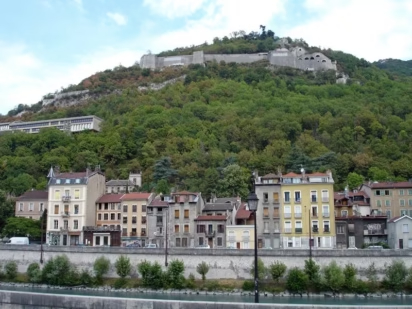Grenoble offers a spectacularly beautiful natural location with mountain views from the old town, cable car, and Bastille fort, as well as art museums and fine dining.
Grenoble has a beautiful location in the Isère Valley in the French Pre-Alps. Top sights in Grenoble include the views from the Bastille fort, which is easiest reached by the town’s famous five-bubble téléphérique cable car, the local art museum, the old town with endless outdoor cafés and restaurants, and boulevards lined by nineteenth-century molded cement facades. Budget travelers will enjoy the excellent and cheap food as well as the possibility of visiting most sights for free. Grenoble is also a great cultural and shopping day-trip destination from nearby French Alpine and ski resorts.
The Téléphérique (Cable Car) Grenoble-Bastille
The symbol of Grenoble is the egg-like Plexiglas bubbles of the Grenoble cable car (Téléphérique) that transports visitors from the old town across the Isère River and up to the Bastille fort. From here, visitors can enjoy marvelous views of Grenoble, the Isère Valley, the mountain ranges (Vercors, Chartreuse, and Belledonne) surrounding Grenoble, and occasionally all the way to Mont Blanc.
The Fort de la Bastille in Grenoble
The Bastille fort overlooks Grenoble from a hill on the northern shores of the Isère River. The main purpose of the mostly nineteenth-century Bastille was to defend French Grenoble against potential attacks by the Duchy of Savoy.
The Fort de la Bastille de Grenoble is freely accessible and presently serves mainly as destination for téléphérique tourists and hikers. Various hiking routes are available from the old town – the fastest takes around half an hour.
Explore the Old Town of Grenoble, France
The old town center of Grenoble is attractive but not extraordinarily beautiful and few buildings are on their own of national importance. When exploring the old town, note the impressive nineteenth-century facades that compare well with some Haussmann streets in Paris. These facades are mostly of pressed cement, used and produced locally before their popularity spread elsewhere.
Grenoble was traditionally the seat of the Dauphine, or crown prince, of France. The former Dauphiné Palais du Parlement has impressive Gothic and Renaissance façades facing the Place Saint-André square where the Café de la Table Ronde (founded in 1739) claims to be the second oldest café in France. Coffee is reasonably priced here – food somewhat less so but not outrageously expensive either.
The former court church, now the Collegiate Church of St André, at the back of the square, dates to the thirteenth and fourteenth centuries. The interior is surprisingly dark and decorations limited.
Grenoble’s Notre Dame Cathedral and Antiques Quarter
The Cathédrale Notre-Dame has a rather unconventional façade for a Gothic cathedral although the five-nave interior is more typical. Parts of the church are Carolingian but most of the building is Gothic.
The adjacent former bishop’s palace now houses a museum with archeological finds from the Isère region. Its best-known display is a very rare fifth-century baptistery.
Between the cathedral and Place de Verdun is the antique quarter, where most of Grenoble’s antique shops are located. Antique prices here are considered to be much lower than in Paris and other French tourist centers.
The lovely squares of Grenoble are lined by outdoor cafés and bistros serving excellent food. However, travelers on a tight budget need only go a few paces from the beautiful squares to find much cheaper restaurants. In addition to local cuisine, Middle Eastern, North African, and Asian eateries are very common too.
Art Museums in Grenoble, France
Grenoble has several museums but the Musée de Grenoble is by far the most impressive. This prestigious museum of fine art is housed in a modern 1990s building with excellent lighting and exhibition facilities. The collection spans five centuries with the late nineteenth-century and twentieth-century works particularly highly rated.
On the north bank of the Isère, in a former monastery, is the Musée Dauphinois with displays of regional arts and crafts. This seventeenth-century building, especially the Baroque chapel, is worth seeing too.
Transportation to Grenoble is easy as the town serves as a major gateway to the French Alpine and ski resorts. Cheap flights to Grenoble Airport (GNB) from London and other European cities are common and fast TGV train connections are available from Paris. Aerocar buses from Geneva Airport run to Grenoble a few times per day.
The mountains that surround Grenoble have beautiful routes to explore by car, bicycle, or on foot on day trips from Grenoble while valley roads give fast access to other towns including Chambéry, Annecy, and Geneva.
The Novotel Grenoble-Voreppe is a comfortable mid-scale hotel with a swimming pool just to the north of the city close to the highways. The hotel is hugely popular with families traveling between northern Europe and southern France, as it often has spectacular bargains during the quiet season, which include most weekends and the summer holiday period.


